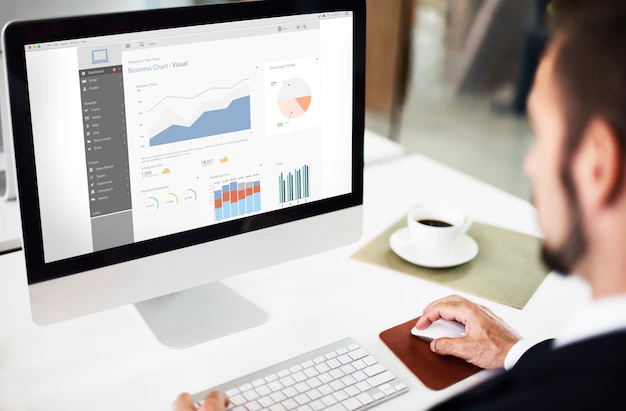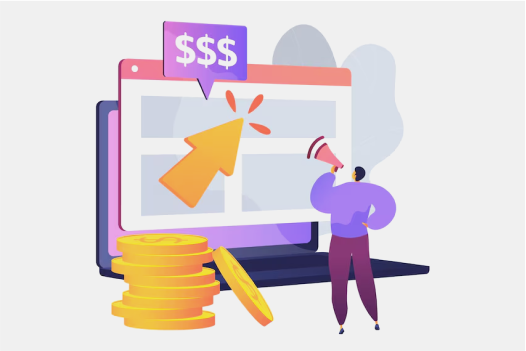Contents
- What is a SaaS Marketing Dashboard?
- Why Use a SaaS Dashboard for Your Business?
- Components of a SaaS Dashboard
- Why building a value-based dashboard Saas is essential?
- Benefits of a value-based dashboard
- Key elements of a Saas dashboard
- What Metrics Should Be Included in a SaaS Dashboard?
- When selecting a SaaS dashboard template, consider the following factors:
- Conclusion
A SaaS marketing dashboard is essential for tracking key metrics, optimizing campaigns, and making data-driven decisions.
A survey revealed that 88.2% of professionals working directly at SaaS companies utilize data dashboards to monitor and analyze their marketing performance.
Whether you're a startup or a scaling SaaS business, having a well-structured dashboard can provide real-time insights into your marketing performance.
What is a SaaS Marketing Dashboard?
A SaaS Marketing Dashboard is a centralized visual tool that helps B2B SaaS marketing teams track, analyze, and optimize their marketing performance. It integrates data from multiple sources—such as website analytics, CRM systems, advertising platforms, and email marketing tools—to provide real-time insights into SaaS KPIs like customer acquisition cost (CAC), monthly recurring revenue (MRR), and lead-to-customer conversion rates.
By leveraging a SaaS marketing dashboard, businesses can monitor campaign performance, optimize marketing spend, and drive data-driven decisions, ensuring sustainable growth in a competitive B2B SaaS landscape.
Beyond data display, these dashboards are catalysts for strategic moves and operational efficiencies, with adjustable layouts to meet various corporate demands. Integration capabilities provide a comprehensive view by effortlessly combining various data sources while strong security measures maintain trust and dependability.
In summary, a SaaS marketing dashboard goes beyond its function as a system, emerging as a strategic ally in making data-driven decisions with confidence and clarity and focusing on growth and SaaS branding.
Why Use a SaaS Dashboard for Your Business?
In the fiercely competitive SaaS market, having a comprehensive SaaS metrics dashboard is essential for gaining a competitive edge. Here are some key reasons why your SaaS business needs one:
- Data Management: SaaS dashboards centralize data from multiple sources, eliminating the need to access different applications and ensuring data quality, speed, and consistency.
- Visibility: With interactive visualizations, dashboards provide a holistic view of business operations, customer behavior, and performance metrics, enabling informed strategy development.
- Cohesion: By providing 24/7 access to information across platforms, dashboards promote cohesion and collaboration within the organization, including sharing insights from SaaS LTV calculation.
- Growth: By identifying trends and patterns, dashboards empower businesses to capitalize on strengths, minimize weaknesses, and drive continuous growth. This is essential for scaling popular SaaS products.
- Communication and Collaboration: Dashboards facilitate cross-departmental communication and collaboration by sharing data-driven insights and ideas.
Components of a SaaS Dashboard
The SaaS KPI dashboard is a strong tool that helps firms gain important insights into their performance indicators. It focuses on critical metrics, including user engagement, churn rate, customer acquisition cost, and lifetime value, providing actionable data for better decision-making. Users can quickly change their plans thanks to real-time data updates.
Customization options enable enterprises to modify the dashboard to meet their requirements, assuring relevance and usability. In summary, the SaaS KPI dashboard enables firms to efficiently analyze their performance and SaaS reviews, identify areas for development, and promote ongoing growth.
Actionable metrics: The SaaS KPI dashboard prioritizes actionable metrics, including user engagement, churn rate, customer acquisition cost, and lifetime value, offering valuable insights into performance.
Real-time data updates: Ensuring access to the most recent data, the dashboard provides real-time updates, enabling informed decision-making based on the latest information, assuring relevance and usability in tracking SaaS lead gen.
Customization: Users have the flexibility to customize the dashboard according to their specific needs, emphasizing the most relevant metrics for their business objectives. This feature enhances user experience and ensures that the dashboard remains aligned with evolving priorities.
Why building a value-based dashboard Saas is essential?
Constructing a value-based dashboard is imperative as it serves as a pivotal tool in user-centric software development. Unlike traditional dashboards that merely present data, a value-based dashboard is meticulously crafted to furnish users with essential insights crucial for attaining their objectives.
It transcends the conventional by delivering not just information but meaningful, actionable saas reporting and insights that foster user engagement, retention, and overall satisfaction.
The significance of developing a value-based dashboard is underscored in the early stages of software product creation. By prioritizing its implementation, developers ensure that users have access to pertinent information necessary for making informed decisions, which is essential for making informed decisions in SaaS sales strategy, steering their actions toward positive outcomes.
This proactive approach aligns with the ethos of user empowerment, elevating the overall user experience and contributing to the long-term success and viability of the software product. In essence, a value-based dashboard becomes a cornerstone in the foundation of user-centric design, driving success and satisfaction in tandem with the users' goals.
Benefits of a value-based dashboard
Enhanced User Experience (UX):
- Incorporating a performance-driven dashboard design improves the overall user experience, making it more intuitive and user-friendly for demand generation examples.
- This, in turn, helps prospects quickly recognize the value of your product, facilitating smoother onboarding processes for critical business perspectives.
Increased Customer Retention and Utilization:
- A value-based dashboard contributes to higher user retention rates by ensuring that users find ongoing value in your software.
- The design encourages regular and effective utilization of the software, leading to a more engaged user base.
Positive Word-of-Mouth Marketing:
- Happy customers, impressed by the value-centric dashboard, become natural advocates for your product.
- This positive sentiment translates into word-of-mouth marketing, as satisfied users are more likely to share their positive experiences with others.
Building Frequent Users:
- Satisfying users, particularly those engaged in repetitive tasks, establishes a positive feedback loop.
- Users find value and convenience in your software, leading to increased frequency of use and a higher likelihood of becoming dedicated, frequent users.
Improved Net Promoter Scores (NPS):
- The positive user experiences derived from a value-driven dashboard contribute to higher Net Promoter Scores.
- Users are more likely to recommend your software to others, creating a positive impact on your overall marketing strategy and customer acquisition.
This blog is your roadmap to developing a successful B2B SaaS referral program and mastering the essential SaaS go-to-market strategy for sustained success in this competitive landscape.
SaaS Marketing Dashboard
Whether you're a SaaS founder, CMO, growth marketer, or part of a performance marketing team, this template will help you track and monitor your marketing efforts.
Key elements of a Saas dashboard
A solid SaaS dashboard has essential components like:
- User-friendly interface: The SaaS dashboard template should be simple to use and comprehend so that users may quickly gain actionable insights and make decisions based on information.
- Real-time data updates: To guarantee that you always have the most recent information, the data on your KPI dashboard should refresh in real-time.
- Key Performance Indicators (KPIs): KPIs give you a clear picture of how well you're doing in relation to your strategic goals. For example, if a KPI is churn rate, which tracks the frequency at which customers choosing to discontinue business with you, if the objective is to boost client retention.
- Customization capabilities: The dashboard should allow for easy connectivity with important business systems for the inclusion of metrics on-demand. It should be created with your specific business requirements and user preferences in mind. Additionally, it should offer a variety of graph designs using powerful charting features to accommodate different visual preferences.
What Metrics Should Be Included in a SaaS Dashboard?

The key to a successful SaaS analytics dashboard is to include the right mix of metrics that provide a comprehensive view of your business. Here are some essential metrics to consider:
Monthly Recurring Revenue (MRR): The predictable revenue generated from monthly subscriptions acts as a reliable indicator of a company's financial health and growth trajectory, facilitating strategic planning and resource allocation.
Annual Recurring Revenue (ARR): Annual Recurring Revenue quantifies the total revenue generated from subscriptions annually, providing insights into long-term revenue stability and growth potential.
Churn Rate: The Churn Rate, representing the percentage of customers who cancel subscriptions, offers crucial insights into customer satisfaction and retention strategies, guiding efforts to minimize attrition and maximize revenue.
Customer Acquisition Cost (CAC): By quantifying the average expense associated with acquiring a new customer, including marketing and sales costs, Customer Acquisition Cost helps optimize budget allocation and assess the efficiency of acquisition strategies, such as backlinking strategies.
Lifetime Value (LTV): Saas Lifetime Value estimates the net profit a customer will generate over their relationship with the company, guiding decisions related to customer retention, loyalty programs, and overall revenue optimization strategies.
Average Revenue per User (ARPU): Average Revenue per User signifies the average revenue generated per user or customer, aiding in evaluating pricing strategies, product offerings, and revenue forecasting within the SaaS market Strategy.
Customer Retention Rate: Customer Retention Rate, representing the percentage of customers retained over a specific period, underscores customer satisfaction and loyalty, influencing retention strategies and revenue stability.
Lead Velocity Rate (LVR): Lead Velocity Rate measures the rate at which qualified leads are generated, reflecting the effectiveness of marketing efforts and providing insights into sales pipeline health and future revenue projections.
Net Promoter Score (NPS): The Net Promoter Score serves as a key indicator of customer loyalty and satisfaction, gauging the likelihood of customers recommending the product or service to others, and guiding efforts to enhance customer experience and retention.
When selecting a SaaS dashboard template, consider the following factors:
- User-friendliness: The dashboard should be straightforward to use, providing rapid access to pertinent information.
- Scalability: As your company expands, the dashboard should be able to handle increased data quantities and changing requirements.
- Security: To secure critical corporate data, ensure that the dashboard uses industry-standard security procedures.
- Integration: The dashboard should work smoothly with your existing systems and data sources, allowing for a smooth flow of information.
- Customization: Look for a dashboard with customization options to personalize the UI and KPIs to your company's requirements.
Conclusion
SaaS dashboards are essential tools for contemporary SaaS companies because they capture the power of data visualization and provide the insights required to drive growth, improve customer experience, and optimize operations. SaaS dashboards including those integrated into SaaS website design and SaaS pricing pages, are the foundation for data-driven decision-making, resulting in corporate success.
As you begin your SaaS journey, thoroughly assess your company needs and select a SaaS dashboard design that corresponds with your objectives. With the correct dashboard in place, you'll be able to navigate the competitive landscape, find opportunities, and make educated decisions to move your company ahead.
Get The SaaS Marketing Toolkit
1. What exactly is a SaaS dashboard?
A SaaS (Software as a Service) dashboard is a web-based tool that provides users with real-time access to key metrics and data visualizations relevant to their business operations. It offers a centralized platform for monitoring and analyzing various aspects of a business, such as sales performance, marketing metrics, financial data, and more.
2. What are some key features to look for when choosing SaaS tools for a dashboard?
Key features to consider include customizable dashboards, interactive data visualization options, real-time data updates, integration capabilities with other business software systems, user-friendly interface, mobile accessibility, and robust security measures.
3. Can SaaS analytics be integrated into existing business software systems?
Yes, SaaS analytics tools often offer integration capabilities with popular business software systems such as CRM (Customer Relationship Management), ERP (Enterprise Resource Planning), and accounting software. This integration allows businesses to leverage their existing data and streamline their analytics processes.
4. How does a dashboard in CRM enhance customer relationship management processes?
A dashboard in CRM provides users with a comprehensive view of customer interactions, sales pipeline, marketing campaigns, and customer support metrics. By having access to this consolidated data, businesses can better understand customer behavior, identify opportunities for upselling or cross-selling, track sales performance, and improve overall customer satisfaction.
5. Can you provide examples of industries where SaaS dashboards have proven particularly effective?
Industries such as e-commerce, healthcare, finance, manufacturing, retail, and marketing have all benefited from the implementation of SaaS dashboards. These dashboards help organizations in these sectors to track and analyze relevant data points, make informed decisions, and optimize their business processes.
6. What makes a dashboard stand out as a good example of effective data visualization?
A good dashboard effectively presents data in a visually appealing and easy-to-understand manner. It should use clear and concise charts, graphs, and other visualization techniques to convey insights quickly. Additionally, it should allow for interactivity, enabling users to drill down into specific data points for deeper analysis.
7. Why was the term "dashboard" chosen to represent this type of data display?
The term "dashboard" was chosen because it draws an analogy to the dashboard of a car, which provides drivers with key information about the vehicle's performance and status at a glance. Similarly, a data dashboard provides users with a snapshot of their business's performance and key metrics.
8. What are some common challenges businesses face when implementing a SaaS dashboard?
Common challenges include data integration issues, ensuring data accuracy and consistency, user adoption, customization requirements, scalability, and training employees to effectively use the dashboard.
9. How can businesses ensure data security and compliance when using SaaS analytics tools?
Businesses can ensure data security and compliance by choosing reputable SaaS providers that adhere to industry standards and regulations. Additionally, implementing encryption, access controls, regular security audits, and employee training on data security best practices can help mitigate risks.
10. Are there customizable options available for creating a sales analytics dashboard to suit specific business needs?
Yes, many SaaS dashboard solutions offer customizable options that allow businesses to tailor the dashboard to their specific requirements. This may include the ability to customize metrics, reports, dashboards layouts, and data visualization options to align with the organization's goals and objectives.
Related Blogs
We explore and publish the latest & most underrated content before it becomes a trend.
7 min read
What is SEO Semantic Markup and How to Make Your HTML SEO-Friendly?
By Vibhu Satpaul
Subscribe to Saffron Edge Newsletter!

Get The SaaS Marketing Toolkit










